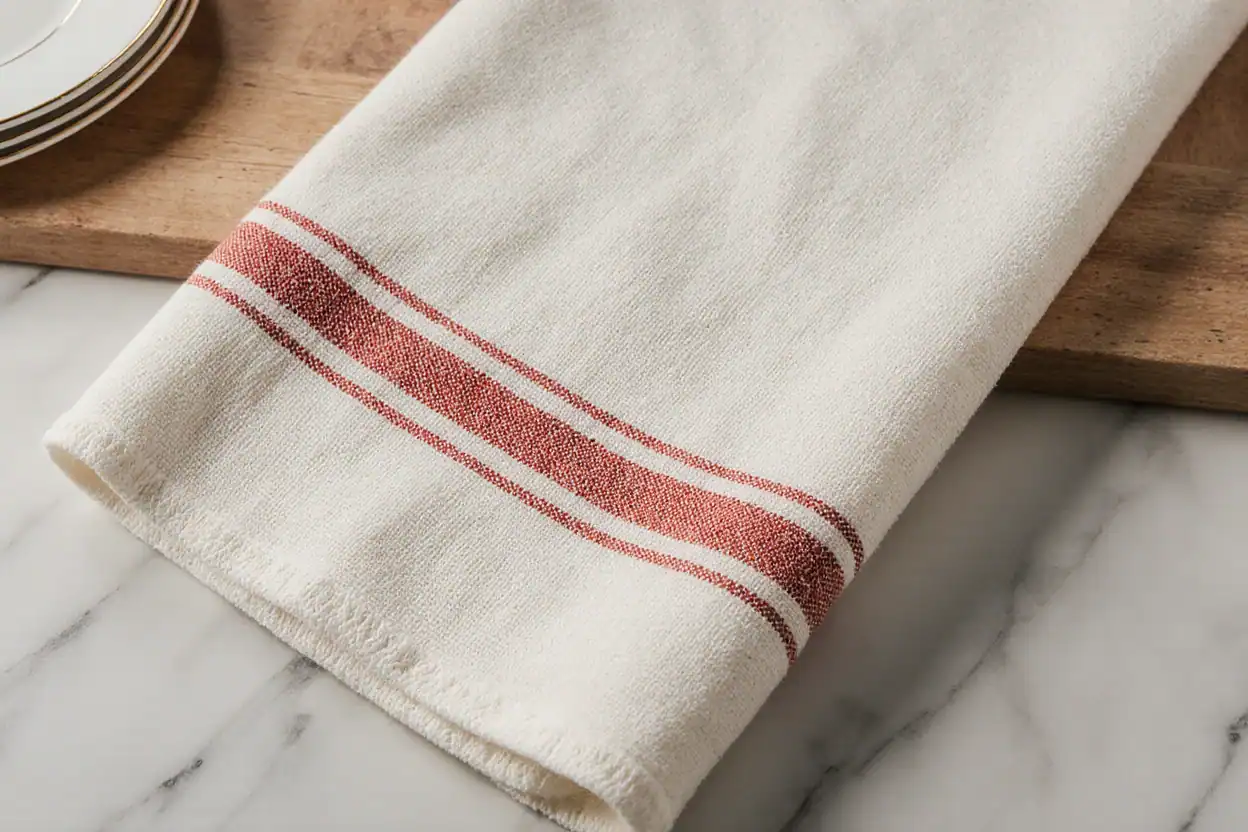A tea towel is a flat‑woven, lint‑minimizing kitchen towel—typically made from cotton or linen—designed for drying delicate dishware and handling food-adjacent tasks with a clean, streak‑free finish. Unlike fluffy terry cloth, tea towels have a smooth weave that excels at polishing glassware, lining bread baskets, covering dough, and elevating kitchen presentation.
Quick Definition Box
- Core use: Drying and polishing glassware, china, and utensils without lint
- Typical materials: Cotton or linen
- Texture: Flat weave (plain, herringbone, damask); not terry
- Common sizes: ~16×28 to 20×30 inches; flour sack towels ~27×27 or 28×28 inches
- Best for: Food handling, baking tasks, presentation, and streak‑free drying
A Short History of the Tea Towel
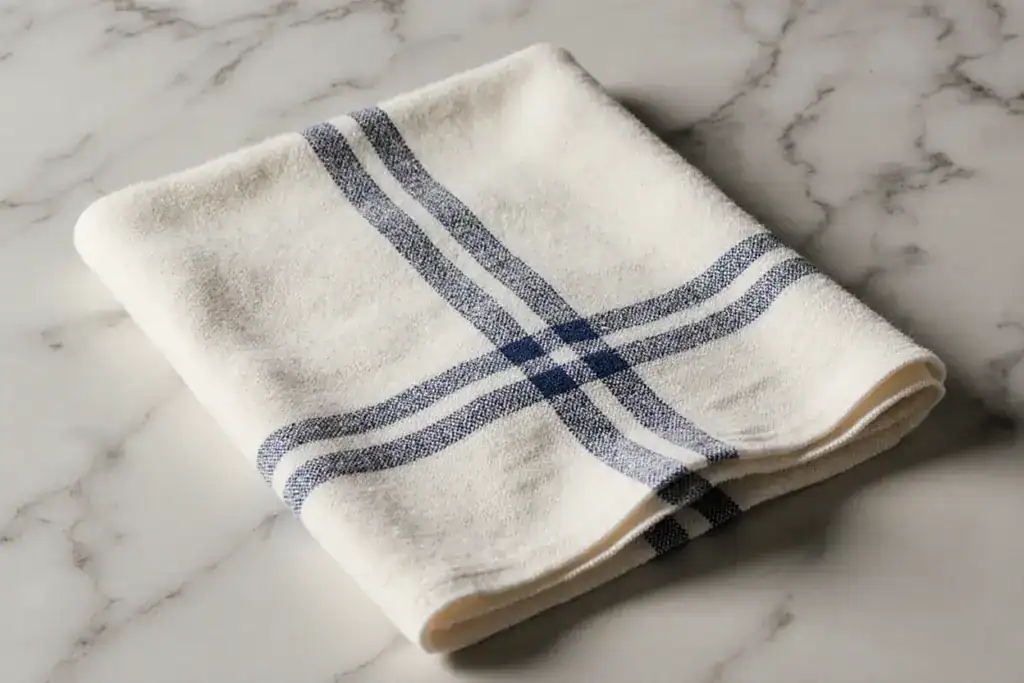
Born out of 18th‑century tea culture, tea towels were used to insulate teapots, protect trays, and dry fine china without scratching. Linen and later fine cotton became preferred because they were absorbent, durable, and didn’t shed fibers onto delicate surfaces. Over time, tea towels evolved into canvases for embroidery and keepsake textiles, bridging utility and décor.
Tea Towel vs. Dish Towel vs. Flour Sack Towel
| Type | Weave & Feel | Best Uses | Pros | Considerations |
|---|---|---|---|---|
| Tea towel | Flat-woven cotton or linen | Polishing glassware, drying china, lining baskets, covering food | Lint-minimizing, sleek finish, versatile | Thinner feel; not ideal for heavy spill cleanup |
| Dish towel | Often terry or plush weaves | General drying, soaking spills, hands | Very absorbent, durable | Can shed lint; not ideal for polishing |
| Flour sack towel | Lightweight, tightly woven cotton; large square | Proofing, straining, herb drying, glassware | Large, flexible, very low lint | Can be very thin; may require doubling for heat tasks |
Sizes, Weaves, and Construction
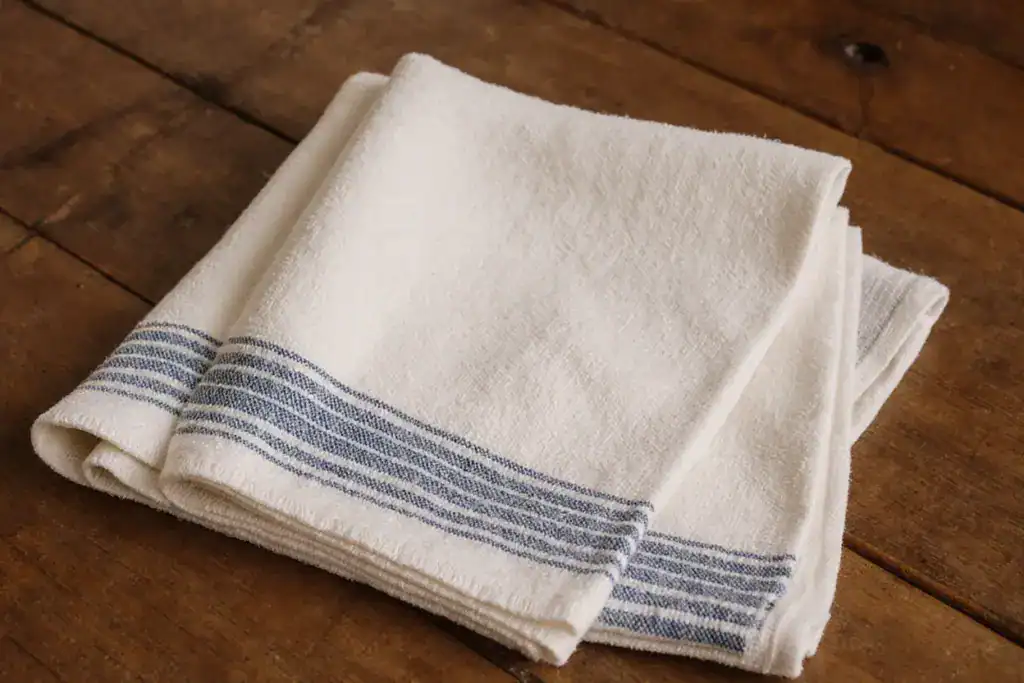
- Sizes: Tea towels commonly range from 16×28 to 20×30 inches. Flour sack towels are typically square (27×27 or 28×28 inches), useful for baking and straining.
- Weaves:
- Plain weave: Smooth and versatile for everyday kitchen tasks.
- Herringbone: Slightly more texture; good absorption while keeping lint low.
- Damask: Decorative patterns woven in; popular for display and gifting.
- Construction details to look for:
- Tight, even weave with minimal light transmission when held up.
- Secure hems and reinforced corners to resist fraying.
- Hanging loop for airflow and quick drying.
Materials: Cotton vs. Linen (How to Choose)
- Cotton
- Pros: Affordable, softens quickly, solid absorbency, easy to find.
- Cons: Lower-quality cotton can lint; can retain odors if not dried thoroughly.
- Best for: Everyday drying, baking, general prep.
- Linen
- Pros: Naturally lint-minimizing, strong when wet, fast-drying, superb for polishing.
- Cons: Higher cost; can feel crisp until broken in.
- Best for: Stemware, stainless steel, showcase pieces.
- Blends
- Aim to balance softness (cotton) and lint control (linen). Quality varies by brand and weave.
Pro tip: For a balanced drawer, keep 2–3 linen polishers for glassware and 4–6 cotton workhorses for daily tasks.
20 Practical Uses for Tea Towels
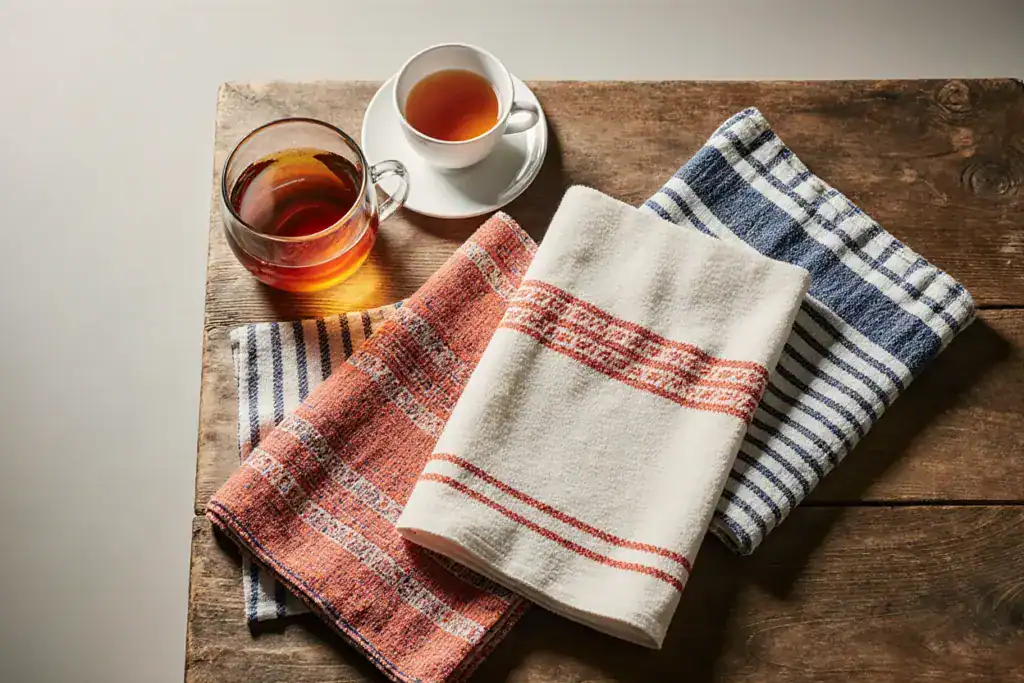
- Drying glassware, knives, and fine china without lint
- Polishing stemware and silverware to a streak‑free finish
- Lining bread baskets; wrapping warm rolls
- Covering dough for proofing
- Acting as a trivet for warm dishes in a pinch (folded)
- Stabilizing cutting boards and mixing bowls on slick counters
- Straining stocks and yogurt (as a cheesecloth alternative)
- Drying herbs and leafy greens gently
- Reusable cloth for produce washing
- Absorbing condensation under cooling baked goods
- Providing a clean landing zone for air‑drying delicate cups
- Lining drawers and shelves for a tidy look
- Folded as a quick potholder substitute
- Reliable bar towel for spills and glass polishing
- Picnic or charcuterie presentation cloth
- Wrapping loaves to preserve crust texture
- Zero‑waste gift wrap or wine bottle wrap
- Guest powder room hand towel with decorative flair
- Embroidery or monogramming project base
- Food styling and photography prop for content creators
Care and Maintenance
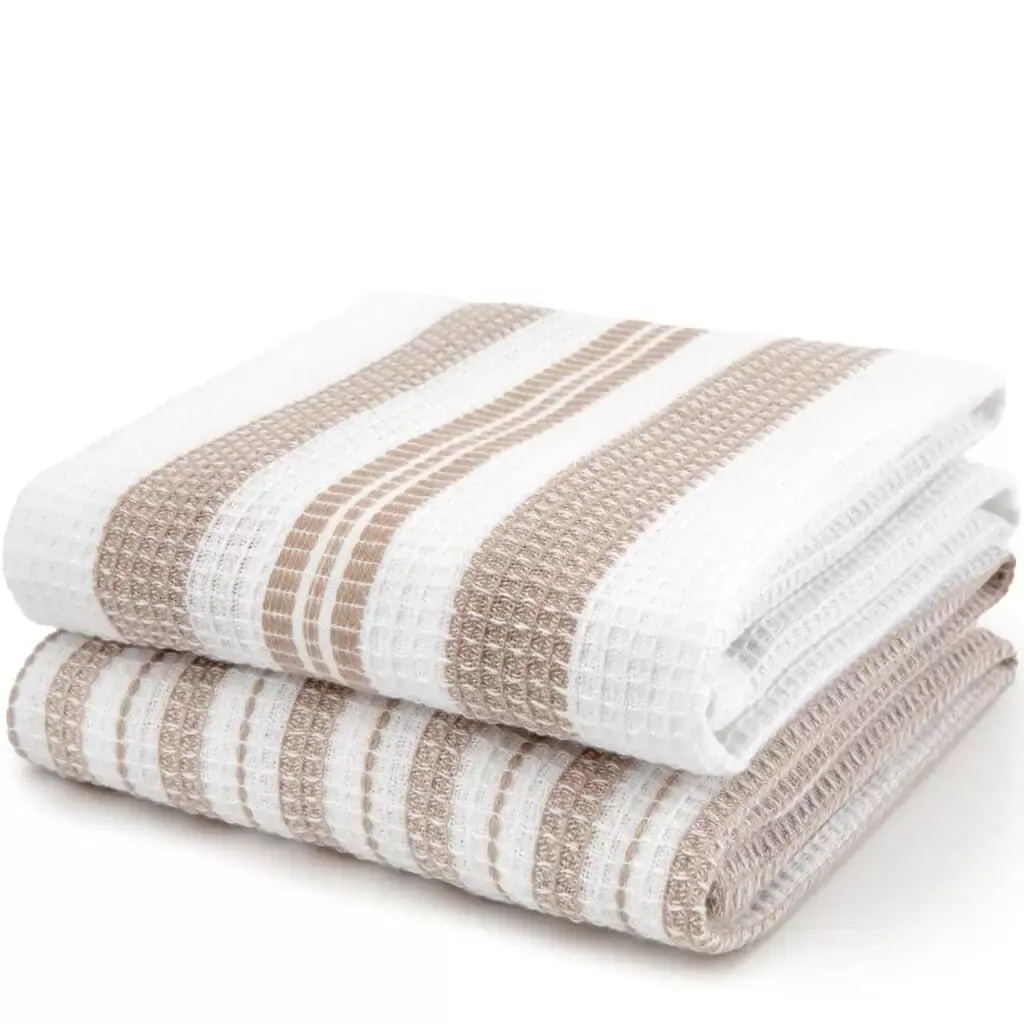
- First wash: Wash before first use to remove finishing agents and improve absorbency.
- Detergent: Use a low‑residue formula; avoid fabric softeners (they leave films that reduce absorbency and can streak glass).
- Temperature:
- Cotton: Warm or hot cycles for thorough cleaning; sanitize periodically if used for food tasks.
- Linen: Cool to warm cycles or delicate setting; avoid high heat to prevent fiber stress.
- Drying: Line‑dry or tumble low. Ensure towels are completely dry before folding to prevent mildew.
- Stains: Pre‑treat oils and pigments; oxygen-based cleaners are gentler on fibers and colors.
- Ironing: Optional—linen irons beautifully for a crisp, polished look.
- Hygiene habits:
- Rotate frequently; replace when visibly soiled.
- Dedicate separate towels for food contact vs. counters/hands to prevent cross‑contamination.
Buying Guide: How to Choose Quality Tea Towels
- Weave test: Hold to light; look for tight, uniform weave with minimal gaps.
- Hem quality: Tug gently at corners; look for even stitching and no loose threads.
- Fiber choice: Premium cotton (long-staple) or genuine linen (e.g., European flax) perform best.
- Weight: Midweight towels balance absorbency and quick drying; avoid overly heavy weaves for polishing tasks.
- Colorfastness: If buying darks or prints, test for dye bleed during first wash; favor reactive or vat-dyed options for durability.
- Hardware: A sewn-in hanging loop improves airflow and dries faster between uses.
- Starter set strategy: Begin with 2 linen polishers + 4–6 cotton everyday towels to cover all tasks.
Eco and Budget Considerations
- Paper‑towel alternative: Tea towels reduce single‑use waste and cut recurring costs.
- Longevity: Proper washing (no softeners, low heat) keeps fibers performing longer, making higher-quality towels cost‑effective over time.
- Multipurpose: One towel can handle proofing, polishing, presentation, and more—minimizing the need for specialized textiles.
FAQs
- Are tea towels food‑safe?
- Yes—when clean and dedicated to food contact tasks. Keep separate towels for raw proteins and general cleaning.
- Why is there lint on my glasses?
- Lower‑quality cotton and new towels can shed. Wash once or twice before use, skip softeners, and consider linen for polishing.
- Can tea towels go in the dryer?
- Yes, on low heat. Line‑drying preserves fibers and reduces shrinkage, especially for linen.
- How often should tea towels be washed?
- Daily for heavy kitchen use or when damp/soiled; immediately after direct food contact (e.g., dough proofing).
- What’s best for bread proofing?
- Clean flour sack or cotton tea towels; flour lightly if needed to prevent sticking.
Styling and Décor Tips
- Seasonal rotation: Use patterned damask or printed cotton for display while keeping a few plain linen towels for polishing.
- Color palette: Neutrals hide wear and match most kitchens; reserve bold colors for accent and décor.
- Gifting: Pair a high‑quality tea towel with a wooden spoon, artisan soap, or a bread mix for a simple, thoughtful gift.
Towelpicks.com Recommendations
- For glassware and polishing: Choose 100% linen, flat weave, midweight, pre‑washed; prioritize tight weave and stitched hanging loop.
- For everyday drying: Opt for long‑staple cotton with a flat or herringbone weave; avoid plush terry for polishing tasks.
- For baking and prep: Keep large flour sack towels on hand; buy in multipacks for rotation and specialty tasks.

